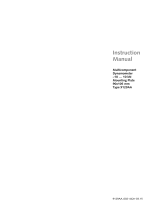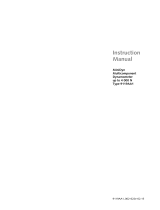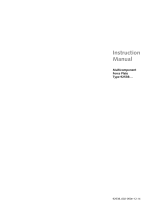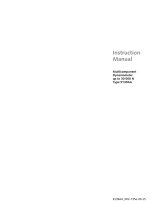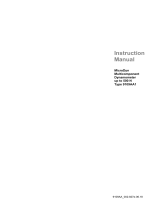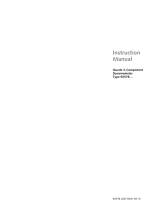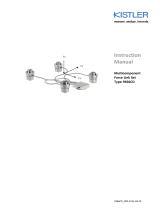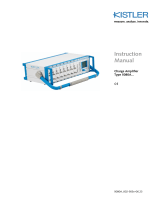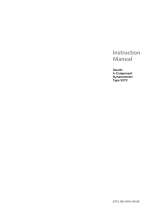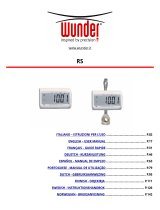Page is loading ...

Instruction
Manual
Ceramic-
Microvibration
Dynamometer
Type 9236A…
9236A_002-883e-12.19


Foreword
9236A_002-883d-12.19 Page 1
Foreword
Thank you for choosing a Kistler quality product charac-
terized by technical innovation, precision and long life.
Information in this document is subject to change without
notice. Kistler reserves the right to change or improve its
products and make changes in the content without obli-
gation to notify any person or organization of such
changes or improvements.
© 2019 Kistler Group. Kistler Group products are protect-
ed by various intellectual property rights. For more details
visit www.kistler.com. The Kistler Group includes Kistler
Holding AG and all its subsidiaries in Europe, Asia, the
Americas and Australia.
Kistler Group
Eulachstraße 22
8408 Winterthur
Switzerland
Tel. +41 52 224 11 11
www.kistler.com

Ceramic-Microvibration Dynamometer Type 9236A…
Page 2 9236A_002-883d-12.19
Inhaltsverzeichnis
1.Introduction .................................................................................................................................. 3
2.Important information ................................................................................................................. 4
2.1For your safety .................................................................................................................... 4
2.2How to treat the instrument ................................................................................................. 5
2.3Tips for using the instruction manual .................................................................................. 6
2.4What happens after modifications? ..................................................................................... 6
2.5Disposal instructions for electrical and electronic equipment ............................................. 6
3.General description of the instrument ...................................................................................... 7
3.1What does a multicomponent dynamometer do? ............................................................... 7
3.2Functional principle ............................................................................................................. 8
3.3Design of the dynamometer ................................................................................................ 9
4.Assembly, installation and putting into operation ................................................................. 10
4.1Important remarks ............................................................................................................. 10
4.2Assembling the dynamometer........................................................................................... 10
4.3Positioning of the dynamometer ....................................................................................... 11
4.4Basic circuitry and cabling of the measuring system ........................................................ 12
4.4.1Force measuring with 3 components (Fx, Fy, Fz) .............................................................. 13
4.4.23-component force measurement ..................................................................................... 14
4.4.3Force and moment measuring with 6-components (Fx, Fy, Fz, Mx, My, Mz) ...................... 15
5.Operation .................................................................................................................................... 17
5.1Range selection ................................................................................................................ 17
5.2Measuring small force changes ........................................................................................ 17
5.3Usable frequency range .................................................................................................... 19
5.4Temperature influences .................................................................................................... 21
5.5Polarity of the measuring signal ........................................................................................ 21
6.Maintenance ............................................................................................................................... 22
6.1Recalibrating the instrument ............................................................................................. 22
6.2Maintenance tasks ............................................................................................................ 23
7.Trouble shooting ....................................................................................................................... 24
7.1Tracing faults and remedying them ................................................................................... 24
7.2Defective dynamometer .................................................................................................... 25
8.Technical data............................................................................................................................ 26
8.1Accessories ....................................................................................................................... 26
9.Annex .......................................................................................................................................... 27
9.1Glossary ............................................................................................................................ 27
9.2Measurement Uncertainty ................................................................................................. 31
9.3Linearity ............................................................................................................................. 32
9.4Frequency range ............................................................................................................... 34
9.5Influence of Temperature .................................................................................................. 35

Introduction
9236A_002-883d-12.19 Page 3
1. Introduction
Please take the time to thoroughly read this instruction
manual. It will help you with the installation, maintenance,
and use of this product.
To the extent permitted by law Kistler does not accept
any liability if this instruction manual is not followed or
products other than those listed under Accessories are
used.
Kistler offers a wide range of products for use in measur-
ing technology:
Piezoelectric sensors for measuring force, torque,
strain, pressure, acceleration, shock, vibration and
acoustic-emission
Strain gage sensor systems for measuring force and
torque
Piezoresistive pressure sensors and transmitters
Signal conditioners, indicators and calibrators
Electronic control and monitoring systems as well as
software for specific measurement applications
Data transmission modules (telemetry)
Kistler also develops and produces measuring solutions
for the application fields engines, vehicles, manufac-
turing, plastics and biomechanics sectors.
Our product and application brochures will provide you
with an overview of our product range. Detailed data
sheets are available for almost all products.
If you need additional help beyond what can be found ei-
ther on-line or in this manual, please contact Kistler's ex-
tensive support organization.

Ceramic-Microvibration Dynamometer Type 9236A…
Page 4 9236A_002-883d-12.19
2. Important information
2.1 For your safety
This instrument has been tested thoroughly and it left
the works in a perfectly safe condition. To maintain
this condition and assure safe operation, the user
must observe the directives and warnings contained
in these instructions
The dynamometer must be installed, operated and
maintained only by persons who are familiar with it
and adequately qualified for their particular tasks
When it must be assumed that safe operation is no
longer possible, the instrument must be taken out of
operation and secured against unintentional use.
It must be assumed that safe operation is no longer
possible if:
the instrument is visibly damaged,
it no longer functions,
it has been in lengthy storage under adverse
conditions,
it has received rough treatment during transport
Important!
Fix the dynamometer according to the instructions. See
section 4.2: Assembling the Dynamometer, for details.
Important!
Fix all parts mounted on the top plate of the dynamome-
ter according to the forces expected!

Important information
9236A_002-883d-12.19 Page 5
2.2 How to treat the instrument
The dynamometer may be used only under the specified
environmental and operating conditions
The insulation resistance is crucially important with
piezoelectric measurements. It must be around 1014
(but at least 1013 )
To obtain this resistance, all plug and socket connec-
tions must be kept meticulously clean and dry
The insulation resistance can be measured with the
insulation tester Type 5493
Protect the signal output against dirt and do not touch
it with your fingers. When the connection is not being
used, cover it with the cap provided
The connecting cable from dynamometer to charge
amplifier is highly insulating. Use only the proper
cable
Do not remove the connecting cable from the dyna-
mometer
When the dynamometer is not in use, protect it by
keeping it in the packing case supplied
When performing long-time measurements, make
sure that the temperature of the dynamometer re-
mains as constant as possible

Ceramic-Microvibration Dynamometer Type 9236A…
Page 6 9236A_002-883d-12.19
2.3 Tips for using the instruction manual
We recommend reading the entire Instruction Manual as
a matter of principle. If you're in a hurry, however, and
you've already gathered experience with Kistler dynamo-
meters, you can confine your reading to the information
that you really need (see section 4).
We have endeavoured to arrange these instructions so
that you can find the information you need without diffi-
culty.
Please keep this Instruction Manual in a safe place
where they can be consulted any time.
If the instructions get lost, just turn to your Kistler cus-
tomer service station and they will be replaced without
delay.
All information and directives in these instructions may be
modified at any time without prior notification.
2.4 What happens after modifications?
Modifications to instruments result in alterations of the
operating instructions as a rule. In such cases, enquire at
your Kistler customer service station about the possibili-
ties of updating your documentation.
2.5 Disposal instructions for electrical and electronic equipment
Do not discard old electronic instruments in municipal
trash. For disposal at end of life, please return this
product to an authorized local electronic waste dispos-
al service or contact the nearest Kistler Instrument
sales office for return instructions.

General description of the instrument
9236A_002-883d-12.19 Page 7
3. General description of the instrument
3.1 What does a multicomponent dynamometer do?
The multicomponent dynamometer provides dynamic and
quasi-static measurement of the 3 orthogonal compo-
nents of a force (Fx, Fy, Fz) acting from any direction onto
the top plate.
With the aid of optional evaluation devices the 3 mo-
ments Mx, My and Mz can be measured as well (see sec-
tion 4.4.3).
The dynamometer has high rigidity and hence high natu-
ral frequency. The high resolution enables very small dy-
namic changes to be measured in large forces.
The dynamometer measures the active cutting force
regardless of its application point. The usable frequency
range depends mainly on the resonance frequency of the
entire measuring rig.
.
Fig. 1: Dynamometer Typ 9236A
Most important applications for the multicomponent dy-
namometer are:
Measurements in the vacuum chamber
Measurements in the clean room
Microvibration measurements
Satellite testing

Ceramic-Microvibration Dynamometer Type 9236A…
Page 8 9236A_002-883d-12.19
3.2 Functional principle
The force to be measured is introduced via a top plate
and distributed between four piezoelectric 3-component
force sensors arranged between the base and top plates.
Each of the sensors has three pairs of quartz plates, one
sensitive to pressure in the z direction and the other two
to shear in the x and y directions respectively. The
measure ment is virtually without displacement.
In these four force sensors the force introduced is broken
down into three components.
Fig. 1: Function principle
For the force measurement in 3 components the individ-
ual signals are led together in the connecting cable.
For force and moment measuring with 6 components, all
8 individual signals are led via the connecting cable
straight to the charge amplifiers.
Depending on the direction of the force, positive or nega-
tive charges occur at the connections. Negative charges
give positive voltages at the output of the charge amplifi-
er, and vice versa.
.

General description of the instrument
9236A_002-883d-12.19 Page 9
3.3 Design of the dynamometer
The dynamometer consists of four 3-component force sen-
sors sandwiched under high preload between a baseplate
and a top plate. This preload is needed to transmit the
friction forces.
Fig. 2: Schematic design of the dynamometer
The four force sensors are mounted ground-insulated.
Ground loop problems are largely eliminated in conse-
quence.
The dynamometer has an especially high natural fre-
quency and is particularly suitable for use in clean rooms
and vacuum chambers. Together with well shielded ca-
bles and high-quality charge amplifiers (see data sheet)
an extraordinarily low-noise measuring chain can be set
up.
1 Force senso
r
2 Base plate
3 Top plate
4 Connector
5 Cap

Ceramic-Microvibration Dynamometer Type 9236A…
Page 10 9236A_002-883d-12.19
4. Assembly, installation and putting into operation
4.1 Important remarks
The multicomponent dynamometer Type 9236A is a pre-
cision instrument, but its inherent accuracy can be ex-
ploited and retained only if it is treated with care. The fol-
lowing rules should therefore be noted:
Mount the dynamometer on a vibration-isolated base,
which is as stiff as possible (e.g. granite table with 10
times the mass), and only use the highest quality ca-
bles and charge amplifiers (Type 5080A). If the Type
9236A is mounted on a soft, cushioning underlay such
as foam, its natural frequency changes dramatically
and the measurements can be strongly distorted.
Never drop the dynamometer or expose it to heavy
impacts! The maximum force of a shock of this kind
could exceed the measuring range of the instrument
and cause permanent deformations
Never use a hammer to position the workpieces, as
such blows might also cause deformation!
On the following pages you will find directions for installing
the dynamometer and basic data for designing the measur-
ing facility.
4.2 Assembling the dynamometer
The following directions must be observed if the dy-
namometer is to be mounted properly:
The dynamometer must be installed only by persons
who are familiar with it and sufficiently qualified for
this work
First the connecting cable has to be mounted. Both
connector sides (dynamometer and cable) have to be
cleaned with Kistler cleansing and insulating spray
Type 1003. To seal the connector the O-Ring is used
(scope of delivery). The mounting surface for the
O-Ring must be clean. The O-Ring is placed properly
and the flange of the cable is mounted onto the
dynamometer by means of two screws (M4x10) and
tightened
Tightening moment = 4,5 N·m
Before mounting the dynamometer on a testing de-
vice, make sure that the mounting surface is perfectly
flat. Uneven supporting surfaces will cause internal
stresses, which may expose the individual force sen-
sors to severe additional shear stressing and cause in-
creased crosstalk

Assembly, installation and putting into operation
9236A_002-883d-12.19 Page 11
The bottom surface of the dynamometer is ground,
i.e. fine-machined. The instrument should therefore
be mounted on ground or equivalently machined sup-
porting surfaces
Clean the contact surfaces thoroughly before mount-
ing
To align the Dynamometer on the machine table one
of the side wall of the flange can be used
Make sure that the dynamometer rests absolutely
flat. Even the smallest air gap will cause undesirable
elasticity and reduce the resonant frequency of the
measuring rig. All mountings must therefore be con-
sidered from the vibration aspect also
Procedure:
Remove the four covers (pos. 5 in Fig. 3) on the dy-
namometer cover plate.
To lift and position the dynamometer, the ring bolts
and washers supplied can be screwed in here.
Tighten the dynamometer with the four supplied
M12x35 screws (strength class 12.9) through the
cover plate.
The Type 9236A2 can also be fixed in the centre with
the supplied M12x50 screw.
Tightening torque of the M12 screws : 130 N·m
4.3 Positioning of the dynamometer
Dynamometers and cables must be placed in a clean
and dry environment.
Lay the connecting cable so that it cannot get cut off
or torn out when working

Ceramic-Microvibration Dynamometer Type 9236A…
Page 12 9236A_002-883d-12.19
4.4 Basic circuitry and cabling of the measuring system
The electrical charges (in pC) delivered from the measur-
ing platform are converted by charge amplifiers into pro-
portional voltages, which may be displayed, recorded or
further processed with usual instruments.
The following rules should be observed when cabling
the measuring rig:
The connecting cable from dynamometer to charge
amplifier must have high insulation and low frictional
electricity. Use only the specified cables therefore
The cable should be laid directly between the dyna-
mometer and the charge amplifier without loops to
avoid additional noise. Ideally, it should lie flat on a
conductive and grounded surface.
Ordinary cables may be used to link the charge am-
plifiers with the display or evaluation instruments
Make sure that all work with electrical connections is
done carefully and cleanly. Remove the protective
caps from the connections only immediately before
connecting a cable
Cabling instructions for specific configurations are
given in the two sections following

Assembly, installation and putting into operation
9236A_002-883d-12.19 Page 13
4.4.1 Force measuring with 3 components (F
x
, F
y
, F
z
)
The following figure shows the elements required for the
connection of the dynamometer to a high-quality multi-
channel charge amplifier Type 5080A, in order to achieve
the lowest possible noise level. It is a ground-insulated
measuring chain with 3-wire cable.
The assignment of the connection cables for the 3 component measurement and the corresponding
extension cable are shown in the figures below. Alternatives to the Type 1687A... cable are listed on
the Type 9236A data sheet ( Doc. No. 003-460).
Fig. 3: Allocation of connection cable Fig. 4: Allocation of extension
3 component measurement cable 3 Component
measurement

Ceramic-Microvibration Dynamometer Type 9236A…
Page 14 9236A_002-883d-12.19
4.4.2 3-component force measurement
The design of a dynamometer ensures that the forces
applied exert no moments on the individual force sensor.
The force sensor can therefore be loaded up to the max-
imum defined measuring range (moment-free). With re-
gard to the zero point of a dynamometer, however, a
force vector whose line of action does not go through this
zero point will produce a moment. Moments cause some
of these sensors to be subjected to an additional load in
one or more directions.
For a 3-component force measurement with a dynamom-
eter consisting of four 3-component sensors, the output
signals (each of Fx, Fy and Fz) of the four sensors are
summed. However, the sum of the four sensors always
shows the correct value irrespective of the force applica-
tion point.
A 3-component dynamometer measures
the three components of all the resulting forces
acting on the dynamometer and their direction but
not their position in space
Depending on the location of the force application point,
the load is distributed over all four sensors. However, al-
ternatively, an individual sensor can receive the main part
of the force. If the force is applied far outside the dyna-
mometer then, according to the law of the lever, an indi-
vidual sensor can experience a multiple of the force to be
measured. For applications of this kind, the load on an
individual sensor must be accurately calculated.
The following rule of thumb applies to the meas-
uring range of a dynamometer
If the force application point of the resulting force
vector is within a pyramid consisting of the cover plate
surface and a height corresponding to the shorter
side of the cover plate, then the maximum measuring
range of an individual force sensor applies for the
entire plate.
If there is a possibility of the acting loads damaging the
dynamometer, please contact your Kistler Customer Ser-
vice Center, where an analysis can be carried out for
your load case.

Assembly, installation and putting into operation
9236A_002-883d-12.19 Page 15
4.4.3 Force and moment measuring with 6-components (F
x
, F
y
, F
z
, M
x
, M
y
, M
z
)
The illustration below shows the elements needed to con-
nect the dynamometer to a high-quality multichannel
charge amplifier Type 5080A..., in order to achieve the
lowest possible noise level. It is a ground isolated meas-
uring chain with 8-wire cable.
The assignment of the connection cables for the 6-component measurement and the corresponding
extension cable are shown in the pictures below. Alternatives to the Type 1677A cable are listed on
the Type 9236A data sheet (Doc. No. 003-460).
Fig. 5: Allocation of connection cable Fig. 6: Allocation of extension
Type 1677A cable Type 1678A

Ceramic-Microvibration Dynamometer Type 9236A…
Page 16 9236A_002-883d-12.19
The individual forces and torques can be calculated as
follows:
Fx = Fx1+2 + Fx3+4
Fy = Fy1+4 + Fy2+3
Fz = Fz1 + F z2 + F z3 + F z4
Mx = b (Fz1 + F z2 – F z3 – F z4) · kMx
My = a (–Fz1 + F z2 + F z3 – F z4) kMy
Mz = b (–Fx1+2 + F x3+4) + a (F y1+4 – F y2+3) kMz
In den obigen Formeln sind a und b die Dynamometer-
Konstanten, während kM Korrekturfaktoren darstellen.
The values for Type 9236A1 are:
a = 80 mm
b = 80 mm
The values for Typ 9236A2 are:
a = 120 mm
b = 120 mm
Deviations occur when measuring the torques because a
dynamometer is not infinitely stiff. These deviations are
corrected by the correction factors kMx, kMy and kMz.
They are normally not provided but must rather be de-
termined through a special calibration. The design of this
special calibration must be as close as possible to the
real measurement design to prevent measurement inac-
curacies.
If the correction factors are available, then they must be
included in the calculation. Depending on the characteris-
tics, the charge amplifier Types 5080A... offers the option
to set the correction factors directly. Factor 1 is already
set for the correction factors kMx, kMy and kMz by default.
Depending on the analysis of the measuring results, the
distance between the cover plate surface and the sensor
center is the deciding factor. This distance is called az0.
The value for Type 9236A1 and 9236A2 are: az0 = 48.5 mm

Operation
9236A_002-883d-12.19 Page 17
5. Operation
5.1 Range selection
It is recommended to use the charge amplifier Type
5080A... for the multi-component dynamometer Type
9236A, in order to reach the lowest possible noise level.
Adjust the sensitivities according to the data in the calibra-
tion sheets for the channels Fx, Fy and Fz. The output
voltage is then set directly to the value corresponding to
the selected scale (...N/V). To adjust the sensitivity, con-
sult the operating instructions for the charge amplifier.
5.2 Measuring small force changes
The piezoelectric measuring technique allows very accu-
rate measurement of small force changes in the pres-
ence of high preload. If for example Fz fluctuations
around 10 N are superimposed upon a main cutting force Fz
of some 20 kN, the following rules can be applied:

Ceramic-Microvibration Dynamometer Type 9236A…
Page 18 9236A_002-883d-12.19
a Set the amplifier to <Reset>. Select the range for F as
follows: 2 · 103 N/V (amplifier to <Long Time Constant>)
b Switch the amplifier to <Operate>
c Apply Fz
d After reading and/or recording the force, switch the
amplifier back to <Reset> so that the charge corre-
sponding to Fz is led off
e Switch the amplifier over to a more sensitive scale
(e.g. 1 N/V for \Fz)
f Set the amplifier to <Short Time Constant>
g Switch the amplifier to <Operate>.
The variations of Fz can now be measured with great
accuracy, because the dynamic response threshold is
around 0,02 N. This means that a \Fz of 0,02 N (as a
change in Fz 20 kN) gives an output voltage of about
20 mV
The attainable resolution is thus:
0000001
1
!
h Switch the amplifier to <Reset>
i Switch the amplifier back to a less sensitive scale
(2 · 103 N/V). Select <Long Time Constant> and
switch the amplifier to <Operate>
k The disappearance of Fz (tool withdrawn) can also be
detected
/
